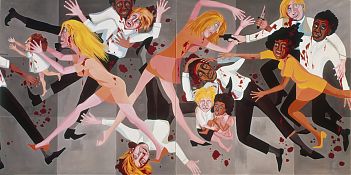Stories Of Race In America Captured On Quilt And Canvas
by Susan Stamberg
July 28, 2013 6:15 AM
In 1963, Faith Ringgold began a series of 20 paintings called “The American People.” She she wanted to create images that would make people really look. “The more they look, the more they see,” she says.
As a black, female artist in the 1960s, Ringgold says there were “a lot of people trying to get in my way and keep me from doing what I was doing.”
Artist Faith Ringgold is best known for what she calls her story quilts — large canvases made in the 1980s, on which she painted scenes of African-American life: sunbathing on a tar roof, a mother and her children, a quilting bee. She frames the canvases in strips of quilted fabric, carrying out an old African, and African-American quilt-making tradition.
The National Museum of Women in the Arts in Washington is showing an earlier aspect of Ringgold’s art: big, strong, vivid paintings from the 1960s that reflect the violence and social upheaval of that time.
Faith Ringgold is now 83 — and still stunning with her long braids and colorful beads. “[It] was important to be determined,” she says of her time developing as an artist in the 1960s. The stop signs that appeared in the pop art movement spoke to her: “There were a lot of stop signs in my life. … People telling you what to do, when to do it, and so on,” she says.
In the ’60s, those days of civil rights struffles and conflicts over equality of ther aces, Ringgold was making traditional art — painting landscapes primarily.
She showed her work to Ruth White, the owner of the popular Ruth White Gallery, who said Ringgold couldn’t be black and simply paint landscapes during such a tumultuous time. “Some people might have been upset or hurt by it,” she says. “But I was happy that she had the courage to tell me that. “
“It was what was going on in America and I wanted [viewers] to look at these paintings and see themselves,” Ringgold says.
So Ringgold changed her work; gave up landscapes and began putting on her canvases the racial and political tumult of the ’60s — and the rage she often felt. In 1963, she began a series of 20 paintings called “The American People,” which depicted confrontations between white and black people. Her 1967 painting Die shows a violent street riot. White and black faces peer through bloodied stars and stripes in The Flag Is Bleeding. “It was what was going on in America and I wanted them to look at these paintings and see themselves. … I wanted to create art that made people stop and look.You’ve got to get ‘em and hold ‘em: The more they look, the more they see.”
Ringgold wanted us to look at the realities of race in this country — the pain and brutality of it — but she found no ready audience. She says it’s taken 50 years to get these tough paintings exhibited. Part of it, she thinks, is because she was showing “too damn much” back then. “You can get by very easily without saying quite so much,” she says.
This led Ringgold to create the story quilts for which she became known. At first, she thought they wouldn’t be embraced as art because quilts are traditionally thought of as a craft, but the opposite happened: “Paintings, people really don’t understand. … They don’t really get paintings. Quilts they do understand because everybody has a quilt in their house.” She thinks it had to do with the comfort and familiarity of the medium. “People like stories,” she adds. “I think I had struck on a combination of imagery and politics that worked.”
These days, Ringgold makes successful children’s book and is working on a new project in which she turns Sudoku into art for smart phones. As for the emotion that inspired her earlier work, Ringgold says it wasn’t really anger — it always came from a place of enlightenment.
“I don’t think you can create art out of anger, it has to come out of some form of understanding,” she says. “You have to feel good about who you are and that you could do something to change things. I would feel angry if I didn’t do anything: If I wasn’t aware, if I was trying to deny, if I had no opportunity. … Anger will stifle you and stop you and make you so that you won’t be able to move. … I wouldn’t allow anyone to do that to me. Because then they win, I lose. I want to win.”
